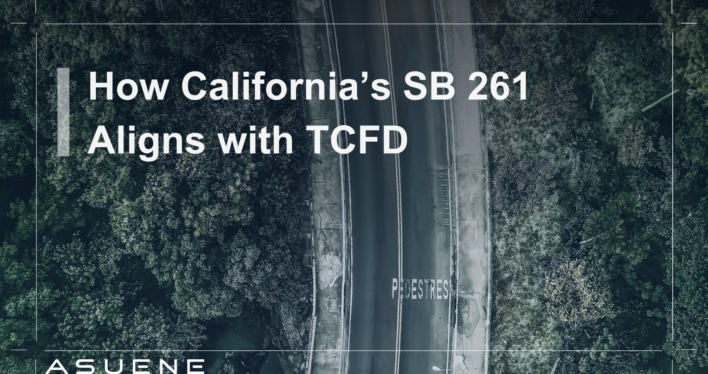- Article Summary
-
Introduction: California Leads Again on Climate Disclosure
California has introduced one of the most significant climate disclosure requirements in the United States through Senate Bill 261, the Climate-Related Financial Risk Act. The law targets companies with annual revenues above 500 million dollars that conduct business in the state. It requires them to publish climate-related financial risk reports every two years, beginning in 2026.
SB 261 is designed around the framework developed by the Task Force on Climate-related Financial Disclosures (TCFD), an international standard that guides how companies should assess and report the financial impacts of climate change. By embedding TCFD principles into state law, California is reinforcing the idea that climate risk is a financial risk. The move represents another example of the state’s leadership in advancing sustainability and corporate transparency.
Understanding TCFD: The Foundation of Modern Climate Reporting
The TCFD was created in 2015 by the Financial Stability Board to help companies disclose clear, consistent, and comparable information about how climate change affects their financial performance. The framework is built around four core pillars that provide a comprehensive structure for disclosure:
| TCFD Pillar | Purpose |
|---|---|
| Governance | Explain how boards and executives oversee climate-related risks and opportunities. |
| Strategy | Describe the actual and potential impacts of climate risks on the organization’s strategy and financial planning. |
| Risk Management | Outline how the organization identifies, assesses, and manages climate-related risks. |
| Metrics and Targets | Present the data used to evaluate climate risks and the goals set to manage them. |
These four pillars have become the foundation of climate reporting worldwide. Many of the most recognized disclosure frameworks, including the International Sustainability Standards Board (ISSB), the EU’s Corporate Sustainability Reporting Directive (CSRD), and the U.S. Securities and Exchange Commission’s proposed climate rules, all trace their structure to the TCFD model.
Inside SB 261: What the Law Requires
SB 261, officially called the Climate-Related Financial Risk Act, translates the TCFD structure into state-level regulation. The law applies to both domestic and international companies that meet the 500 million dollar annual revenue threshold and operate in California. The main elements of the legislation include:
- Biennial reporting on climate-related financial risks starting in 2026.
- Alignment with the TCFD framework for disclosure structure.
- Public accessibility of the reports, typically through company websites.
- Encouragement of third-party verification to enhance report credibility.
The following table compares TCFD’s four pillars with SB 261’s reporting requirements:
| TCFD Pillar | SB 261 Reporting Focus |
| Governance | Board and management oversight of climate-related financial risks. |
| Strategy | Description of how climate risks affect operations, supply chains, and financial planning. |
| Risk Management | Procedures to identify and mitigate physical and transition climate risks. |
| Metrics and Targets | Indicators and targets that show progress in managing climate exposure. |
SB 261 works alongside Senate Bill 253, which requires companies to disclose their greenhouse gas emissions. Together, the two laws cover both the physical and financial sides of corporate climate accountability.

Why TCFD Alignment Matters for Businesses
The alignment between SB 261 and TCFD offers a clear path for companies to build credible, comparable, and investor-ready climate disclosures. For organizations that already report under TCFD or similar frameworks such as ISSB or CDP, compliance with SB 261 will be more straightforward. The integration also provides business advantages beyond compliance.
First, it improves consistency in data reporting, which allows investors and regulators to compare performance across industries. Second, it strengthens investor confidence by showing that companies are prepared for climate risks that could affect cash flow, supply stability, or asset value. Third, it supports strategic resilience by embedding risk analysis into core management decisions.
A blue-toned matrix or bar chart can visually demonstrate how the main global disclosure systems (TCFD, ISSB, CSRD, and the SEC proposal) share similar pillars and objectives. This visual helps readers understand that California’s approach fits within a global pattern of harmonized climate reporting.
For companies beginning this process, several steps can make reporting more effective:
- Map governance roles and responsibilities related to climate oversight.
- Conduct scenario analysis to understand how different climate outcomes affect operations.
- Develop and disclose clear metrics to track progress on climate risk mitigation.
- Ensure internal alignment between sustainability and financial teams.
Conclusion: SB 261 Turns Best Practice into Policy
SB 261 represents an important evolution in U.S. climate policy by turning the TCFD framework from voluntary guidance into enforceable law. This transition reinforces the growing understanding that managing climate risk is an essential part of managing business risk.
California’s initiative is likely to influence how other states and federal agencies approach climate-related financial regulation. For companies, early preparation is a strategic advantage. Building strong governance, risk management, and reporting systems today helps ensure compliance and improves long-term competitiveness.
As more jurisdictions adopt similar approaches, the ability to disclose climate risks clearly and consistently will define leadership in the next phase of corporate transparency.
Download Our Whitepapers

For a deeper dive into compliance strategies and emerging disclosure trends, explore our whitepapers:
- California’s New Climate Disclosure Laws / 10 Pioneer Initiatives by U.S. Businesses, States and Cities
- TCFD Framework: Key Processes and Considerations at Each Stage
- U.S. State Disclosure Regulation 2025 – CA, NY and IL
These resources provide timelines, reporting strategies, and practical checklists to help your business stay ahead of California’s climate accountability rules and prepare for the next era of corporate disclosure.
Why Work with ASUENE Inc.?
ASUENE is a key player in carbon accounting, offering a comprehensive platform that measures, reduces, and reports emissions. ASUENE serves over 10,000 clients worldwide, providing an all-in-one solution that integrates GHG accounting, ESG supply chain management, a Carbon Credit exchange platform, and third-party verification.
ASUENE supports companies in achieving net-zero goals through advanced technology, consulting services, and an extensive network.

